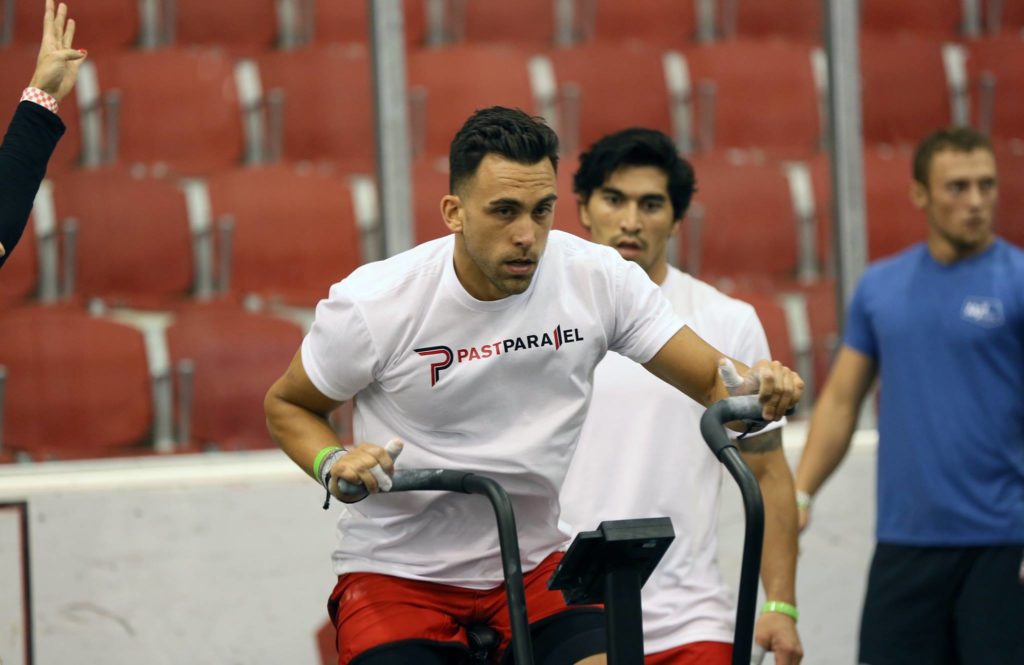
Invictus Athlete and Coach, Chris Fuller, on the Assault Bike at the Granite Games.
How to Assault Bike Like the Pros
Written by Nichole Kribs; Interview with Jared Enderton
Ah, the Assault Bike. Many of you love to hate it for the insane leg pump you get within 15 seconds of riding the bike, for the mental push you must to have in order to keep going and not flop onto the floor, for your heart rate skyrocketing within .8 seconds of being on the bike, to name just a few. But these are some of the reasons that a few people, myself included, absolutely love the Assault Bike! The ability that a piece of equipment has to test so many things (from physical tests to mental tests) is unrivaled in the fitness world.
Many athletes just jump on the bike, close their eyes and pray they reach the desired time/calories needed for the workout without totally annihilating themselves. However, with that mentality, I often see a lack of technique when athletes get on the bike. Instead of being methodical about their seat settings, foot placement and energy exertion, they just get on and put the pedal to the metal. We want that mentality to change by providing you with some tips on how to Assault Bike like the pros.
Fortunately for us, I was able to interview Jared Enderton, who is the strength and conditioning coach of the Team USA Sprint Cycling Team. The Sprint Cycling Team athletes are very power-based and are used to working for short durations. They took note of how many CrossFit athletes ride the Assault Bike and came back to Jared with some insights.
Nichole: What did your cyclists initially say to you about your Assault Biking?
Jared: They were like ‘oh my gosh, what are you doing?’ They said I was using my arms way too much; that was probably the biggest thing. They emphasized that the legs are what is driving the bike so don’t try to move it significantly with your arms. They actually said that moving with your arms too much will make you lock up sooner. Your arms just fatigue you out systematically way faster.
Nichole: Interesting! You see lots of athletes using their arms to move the bike but it seems like that isn’t the most efficient way.
Jared: Yeah they said that you really need less movement with the upper body. The upper body is just controlling all the power with the lower body so focus on your leg drive on the bike.
Nichole: And how do you do that?
Jared: Well one big thing is to not let the knees flare out. It is really common to see people flare their knees out at the top of the revolution but doing this doesn’t allow you to apply force straight down on the bike. Instead, try to keep the knee in line with the foot by not letting the knees flare out or sway a ton. Swaying a ton generally means you are using too much arms, therefore the knees are flailing about and you are losing power from your legs.
Nichole: Totally makes sense! Now where would you adjust the seat for optimal leg drive?
Jared: Well one important thing in measuring for the seat adjustment is making sure that the ball of your foot is on the pedal, not the heel on the pedal. I see most people have their entire foot on the pedal but my cyclists have encouraged me to just have the ball of the foot on the pedal. From there, when setting your seat up, the ball of your foot just be the only thing on the pedal and your leg shouldn’t be locked out at the bottom of the revolution. This seat up may take a little while to get used to because sometimes you feel like you are reaching a bit but this set up definitely helps. It helps prevent you from bringing the knee up too high at the top of the revolution and helps you express the most power from your legs at the bottom of the revolution.
Nichole: What about the seat placement?
Jared: This is interesting because my cyclists said that it is totally dependent on the athlete. All of them ride differently so it is really up to each person and their body type. Placing a seat further over the top of the pedal means you will be more quad driven and placing the seat further back behind the pedal means you will be more posterior chain driven.
The important thing is to play around with it and find out what feels best for you. Do some time trials with different seat positions and then, using the results from your time trails, chose a seat adjustment based on the workout requirements.
Nichole: And what about head position?
Jared: Yeah, so you don’t want to let your head cramp down while you are looking down at the monitor. Try to look ahead so that you can breathe. Keep as neutral a head position as possible and only look down at the monitor with your eyes so that you aren’t closing your airway. Personally I have been trying this out more and more and it has helped me be way more calm on the bike.
The key is to just continue to try different seat adjustments and do a bunch of testing to help you figure out what works best.
Nichole: So helpful Jared! Thank you so much for sharing what you have learned from your cyclists!
Stay tuned for more articles on breathing and the Assault Bike!
Also Check Out…